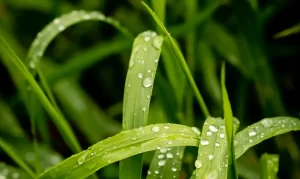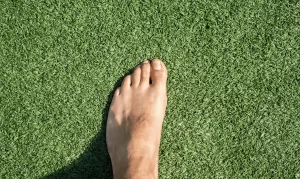Tips for Keeping Your Grassland Alive after heavy rain: If you have grassland, it is a matter of concern for you how long does it take for grass to dry after rain. You may ask several people and have different opinions.
The most popular sayings among them are- it takes around 1-2 days for the grass to dry after rain. But that’s not all you need to know for solving your issue. If you always think of mowing your grass after 1-2 days of rain, you may fall into disaster. Do you know why?
There is no accurate time to answer about how long for the grass to dry after rain? Rather, it depends upon different factors of weather. So, to have the best suggestion, you need to know about the effective points. Do you have many ideas about the key factors of drying out your lawn or garden?
In this article, you will have a brief idea about those important factors which are discussed. This will help you to decide for yourself how long you can delay cutting your grasses after the last rain. Let’s dive into the factors impacting the dryness of grasses.
Contents
Five Key Factors: How Long Does it Take for Grass to Dry After Rain?
In normal weather, grasses may dry out within a few days after rain. But this period may be delayed or shorter according to few key factors. These key factors governing the drying out of the grasses are as follows –
1. Weather and Location
The geographical position of your lawn makes a huge impact on the fact of how long does it take for grass to after rain in your land. For example, if your land is sloppy and facing much temperature, there is a lot of impacts on your grasses. Grasses will dry out faster compared to their actual time. Do you know why?
It’s because of the high temperature causing water loss of your grassland. Regular high temperature disrupts regular physio-chemical activities of grasses. As a result, the geographical position makes a remarkable difference in how long your grass will be valid. The warmer the region is, the faster the lawn will dry out. But that’s not all about the impact of sunlight. Have you ever noticed the difference between grasses in moderate sunlight areas and those in shady areas? Grasses are badly affected by sunlight. Sunlight is one of the key factors that cause quick dry out of grasses. Grasses in low sunlight take much more time to dry out. The accurate weather and location time on grass are essential for the desired results. Thus, both high temperature and sunlight will cause quick dry out of grasses and vice versa.
2. Duration of Rain
Do you remember how long it was raining last time? You need to follow the duration of the rain carefully. Because it is very relevant to how long it will take for the grass to dry.
If it rains for a long time, the land will reserve a lot of water. So, the grass will dry out late. Even while it is raining, no matter it’s heavy or normal rain, the land will not even start to dry same goes for grasses. So, the longer the duration of rain is, the later the grass will dry out. But If you are thinking about is too much rain bad for grass, then the answer is yes. The problems that occur are:
- Loss of vital nutrients.
- There will be poor roots.
- More amount fertilizers will be needed.
- There will be more insects and weeds.
3. Rain Intensity
Rain intensity affects the period of grass dry out as much as rain duration. Rain intensity refers to how heavy the shower is. If the rain intensity is higher, the grasses will be moist. Also, the wet grass takes much time to dry out. Now you must understand what can happen in the opposite case. Low rain intensity will cause a much quicker dry out of the grass.
4. Soil pH
If you face brown spots in your lawn or grassland, that means you are having issues with the soil pH level. When the level of pH is high in the soil, brown spots occur more often. High pH means that the soil is more acidic, it will remove the effectiveness of the fertilizer completely. Some high pH lawn symptoms are:
- The soil has become more limp and yellow.
- The applied methods are not working.
- As there is high pH in the soil, the grass will not get the proper supply of elements.
Well, what harm does the soil pH does to your lawn?
pH is the measure of the level of acidity or alkalinity in any substance. Soil pH does change with the climate conditions. The harm that the soil pH does to your lawn is it directly the ability of the grass and plants. It engulfs all the nutrients and minerals which are necessary for grass growth. Though pH level can be tested in many ways, such as soil sampling, comparing the previous results, and many more. In the end, the grasses will dry out quickly. So, you need to be careful if there is any brown spot on your land.
5. Evaluate your Land Properly
We have gone through the most impactful factors causing dry out of grasses. But do you know how to identify if your grasses are drying or not? Identifying dead grass is not something so easy. But there are several ways to test if your grasses are dead or not. Some are:
-
Have a Tug Test
The tug test is a popular method of testing grass. The method is so simple. You just need to grab some of the lawn and put on it a short tug.
- If the grass seems to show no reaction or obstacle to pull out, the grass is dead.
- If the grass shows resistance in the tug test, the grass is just dormant, not dead.
-
Check Droplets
Droplets in the blade of grass are a good indicator of your grass being dry or dead. If there are droplets present in the blade of the grasses in the morning, it is a good sign. The presence of droplets ensures that your grasses are no way near drying out.
-
Have a walk on the grass
If you are confused about applying the above two ways, there is another option for you. Sometimes it becomes so difficult to identify the real condition of the grass just by having a look. In such a case, you can have a test walking upon the grass. If you can easily walk without your shoes being moist, it’s not a good sign for your grasses. It means your grasses are in the way of drying out. So, you need to decide about mowing your lawn as soon as possible.
Final Thought: How Long Does it Take for Grass to Dry After Rain?
In this article, we have tried to give you some suitable ideas about how long does it take for grass to dry after rain. In common, grass takes around 1-2 days to dry after rain. But this is not that much of a fixed time schedule. The period of grass drying out may shorten or delay according to the factors discussed above.
Learn more about How Long After Spraying Roundup can I Plant Grass Seed?
You have to keep a Hawkeye on the location and weather of your lawn, rain intensity, and its timespan, and soil pH; by that, you can determine how long your grass will stay alive. We also have shown several ways to evaluate your grassland. We are hoping this will be helpful in making the right decision. Have a happy green time!




